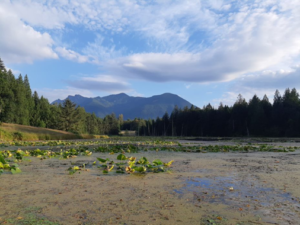Bullfrogs in Ryder Lake
In the last few years, bullfrogs have been detected in the Ryder Lake area, leading to the creation of the Bullfrog Control and Biodiversity project that aims to protect native amphibians. In their native habitat (Eastern and Central North America) bullfrogs have natural predators that keep their numbers down. Outside of their native ranges, and when sufficient predators are not around, bullfrogs are an invasive predator that can cause serious harm to wetlands. They have voracious appetites and are “gape-limited” predators, meaning they eat anything that will fit in their mouths. This includes invertebrates, other frogs, turtles, snakes, birds and small mammals. The presence of bullfrogs could be disastrous for the native species that rely on these wetlands for part of their lifecycle. The wetland in Figure 1 is one of the largest waterbodies in the area and is one of the target locations of our bullfrog control efforts because it is an important breeding location for the at-risk Western Toad and Northern Red-Legged Frog (Figure 2), as well as four other native amphibians.

Figure 2 – Native amphibian species. Western Toad (left), Northern Red-legged Frog (Middle), Northern Pacific Treefrog (right).
Bullfrog Control
As the first official field season of the Fraser Valley Conservancy’s Bullfrog Control and Biodiversity Research project comes to a close, we can take the time to reflect on a great start to what is hopefully a very successful bullfrog control program. In the 2020 field season we successfully removed over 1400 bullfrogs from the Ryder Lake area and we plan to continue this momentum into 2021.
In addition to targeting adult and juvenile bullfrogs we are always on the lookout for bullfrog egg masses, like the one in Figure 4. This year, we were able to successfully locate and remove 2 egg masses from the wetlands. Hopefully we didn’t miss any in the dense vegetation! When searching for bullfrog egg masses it is important to remain vigilant, as the bullfrog eggs can develop into tadpoles very quickly (only 4-5 days if the temperature is right) and each egg mass contains roughly 20,000 eggs! Luckily for us, bullfrogs breed later than our native species so their egg masses should be the only ones around in the summer months. Their egg masses are also large and obvious, so it makes detection a little easier.

Figure 4 – American Bullfrog egg mass. Photo Credit: Kendra Morgan
Biodiversity
While one goal of this project is to control the bullfrogs in the Ryder Lake area, we also aim to understand the impacts that these invasive predators have on wildlife and sensitive wetland ecosystems like our study area. Our project also involves creating a “biodiversity baseline”, which is a list of everything living in the wetlands. Though this is a daunting task, it is fundamental in helping us determine the potential impacts of bullfrogs. Below are just a few of the cool things we have found while conducting surveys this year.
Our biodiversity baseline is not complete, but year 1 biodiversity data collection efforts revealed over 50 species of vegetation, 55 species of invertebrates (including 1 crayfish and 1 bryozoan), 20 bird species, 15 mammal species (including 8 bat species), 2 reptile species (including the invasive Red-Eared Slider) and 7 amphibian species (including the invasive American Bullfrog and 2 species at risk). During our spring egg mass surveys, we target native amphibian egg masses and in 2020 we found: 139 Northwestern salamander, 4 Long-toed salamander, 51 Northern Red-Legged Frog, and hundreds of Northern Pacific treefrog.
Research
There are so many questions about bullfrogs that we still do not have answers for. Part of our future bullfrog research initiative will involve creating a network/partnership with other groups and research institutions to help us understand these creatures and their potential impacts. In 2020/2021 we started to investigate partnerships to focus on gut content analysis and frog limb deformity research using our captured and euthanized frogs, and we will continue to build these partnerships in the future.
In 2021 we plan to continue controlling bullfrogs and monitoring native amphibian species in the Ryder Lake area.
If you want to learn more about bullfrogs in the Fraser Valley click here.






